Russia – Objective Murmansk 4WD Touring in the Russian Kola Peninsula
What destinations come to mind when you think of travelling to the North? Scandinavia, Karelia, Lapland? And even more to the northeast? The Russian Kola Peninsula, located between the White Sea and the Barents Sea. And in Kola, you find the largest city north of the polar circle: Murmansk.
Murmansk is known for having a port which is ice-free all year round and also for hosting the Russian military fleet and its submarines. But Kola is a lot more than just Murmansk. What else is there to explore in this enigmatic peninsula in the north of Russia, which is accessible to 4×4 explorers from all over Europe?
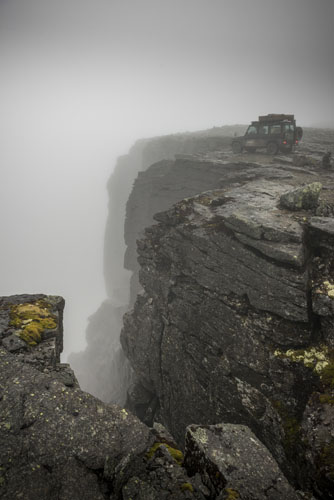
To find some answers to this question, we headed off in early September to participate in the ‘Arctic Tour’ a unique 4×4 expedition organized by the Swiss organization GekoExpeditions (Geko are also known for their guided overland expeditions in Iceland, crossing the Namib desert,and other exotic destinations such as Madagascar, Algeria andMongolia).
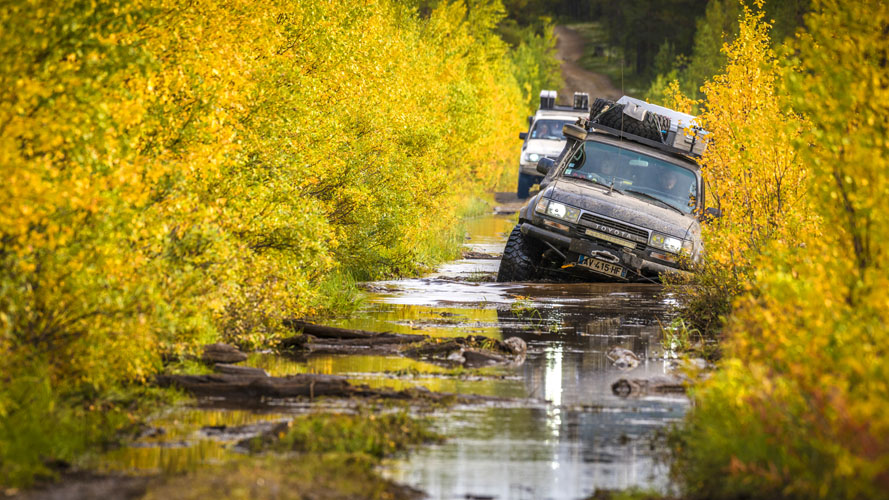
This trip has a wide appeal and is aimed as much at people wanting to explore the remote northern places above Europe as to those over-landers more accustomed to exploring Africa. This trip is a real adventure and is also a deep immersion in a vast and imposing natural wilderness.
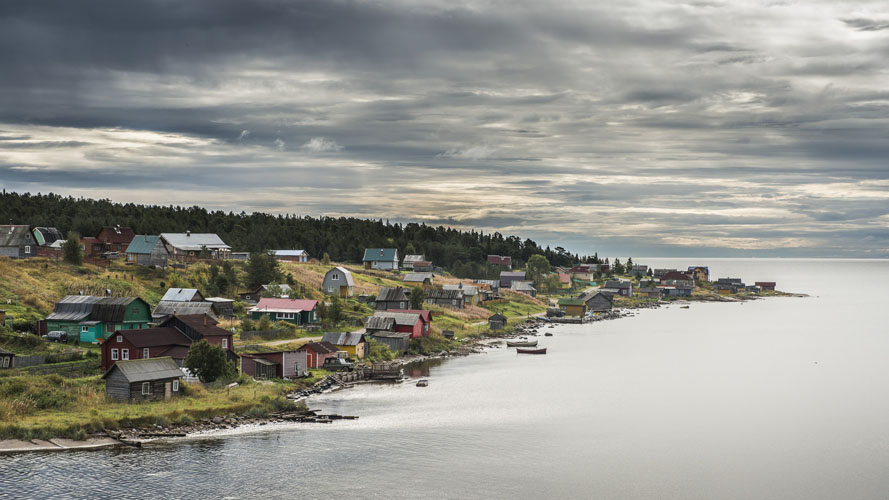 The trip takes place at the ideal time of year (early September) when a riot of colours in nature abound, the northern lights begin their cosmic light-shows and there are less mosquitoes than in summer, and yet it is still pleasantly warm.
The trip takes place at the ideal time of year (early September) when a riot of colours in nature abound, the northern lights begin their cosmic light-shows and there are less mosquitoes than in summer, and yet it is still pleasantly warm.
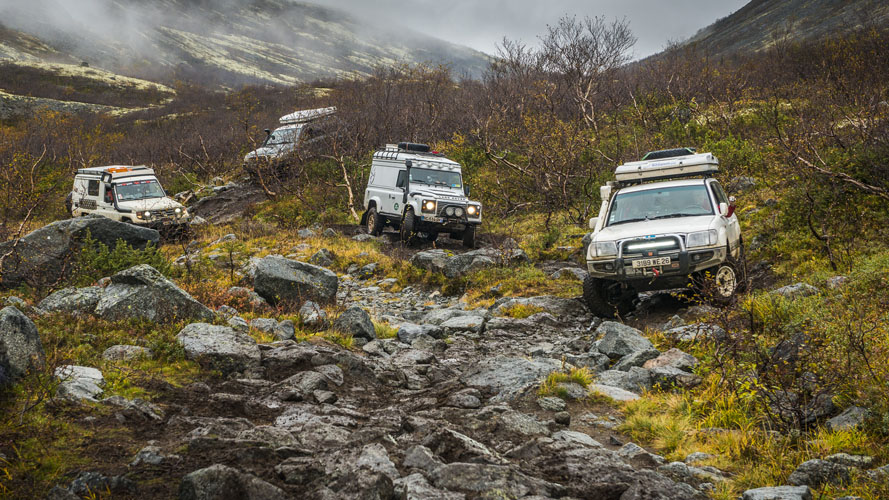
As our adventure begins, arriving at a crowded quay in the small town of Travemünde, in Northern Germany we meet Nicolas Genoud, from Geko Expeditions. Nicolas and some of the other participants in the upcoming trip have gathered for a meal on a terrace. The atmosphere is wonderful and everyone is excited to get started on the trip. After the meal, some additional participants join the party at the rendezvous point at the port of embarkation of the ferry to Finland.
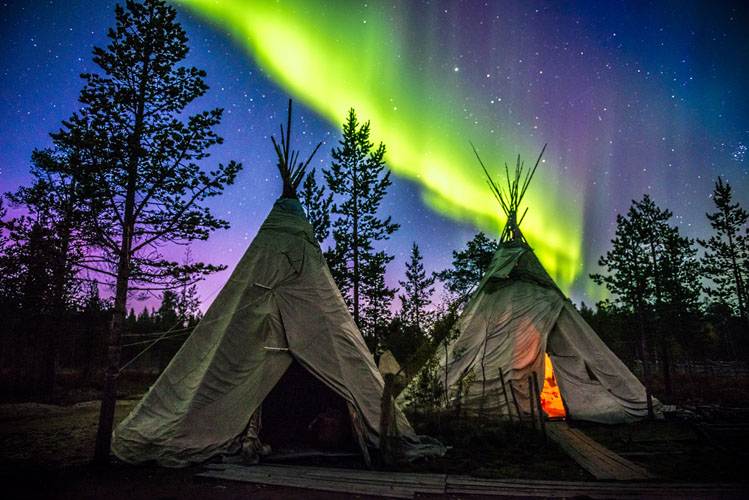
Following a very pleasant crossing the journey continues as the group traverses Finland. A beautiful straight road crosses forests and lakes for nearly 900 km.
Early the following morning we arrive at the Russian border. It is here that the evidence of the benefit of travelling with Geko Expeditions begins to become very apparent.
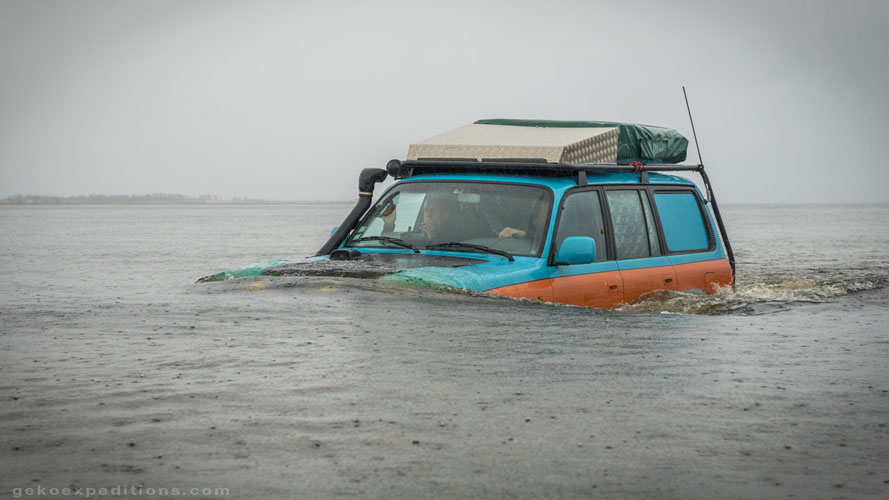
Since the agency had already
provided us with all of the necessary documents for obtaining the visa (including special zone authorizations), all that was left to do was to wave at the customs officers. Our itinerary (previously approved) is thus fully under control. Geko also provides all of the necessary insurance coverage for vehicle entry.
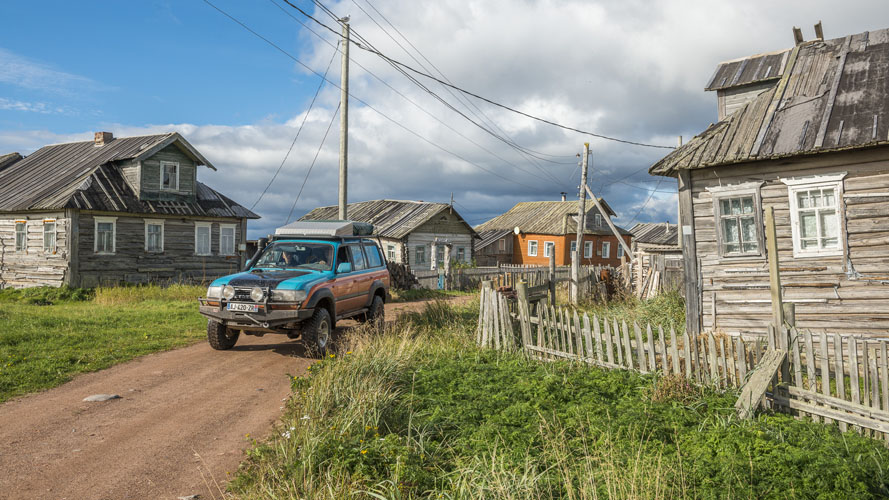
The recent hardening of Russian-European relations does not do us any favours, and to our great despair, our sausages and delicious special cheeses do not get past the border. We are mournful as these will be impossible to replace in Russia.
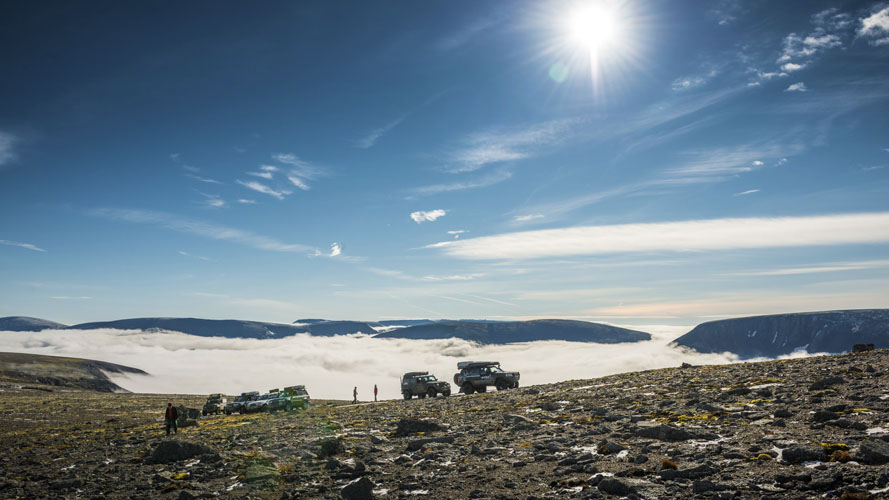 On the plus side, Russia is rapidly evolving, even in its most remote regions and we will have no problem replenishing our supplies with quality alternatives in the three cities that we will pass through on our trip. We enter the first of these cities, Kandalaksha, at the end of this day. And this is the real starting point of our adventures.
On the plus side, Russia is rapidly evolving, even in its most remote regions and we will have no problem replenishing our supplies with quality alternatives in the three cities that we will pass through on our trip. We enter the first of these cities, Kandalaksha, at the end of this day. And this is the real starting point of our adventures.
WE DID NOT COUNT ON THE F**** ROUND STONES
It is with great enthusiasm and some impatience that we begin the next day. The first part of this tour entails the exploration of the south coast of the peninsula of Kola. We travel for two days along the White Sea. To our surprise, the weather is pleasant despite the fact that we are already north of the Arctic Circle. The light on the coast is soft, it is almost unreal.
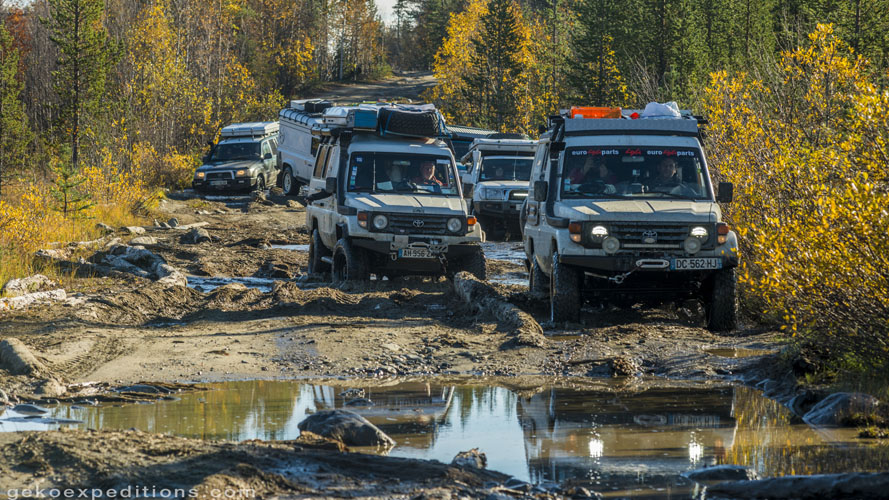
We traverse forest tracks, open tracks across beaches, and cross coastal rivers at low tide. Normally none of this should be a problem, with water levels of 40 to 50 cm, but we did not count on the seemingly omnipresent round pebbles. The first vehicles get stuck and from the very first day our fishing waders serve us well.
That night we camp in a majestic and calm cove, surrounded by a pine forest where bears patrol (we see lots of fresh dung on the access track.) Off on the horizon of the bay we can see the Russians calibrating their new military submarines. For dinner, Nicolas, prepares a salmon for us, which he bought earlier during the day from some local fishermen. He prepares it in papillote cooked with embers. Delightful. The evening continues with great laughter around a welcome campfire where everyone trades stories of their previous 4×4 tours and adventures.
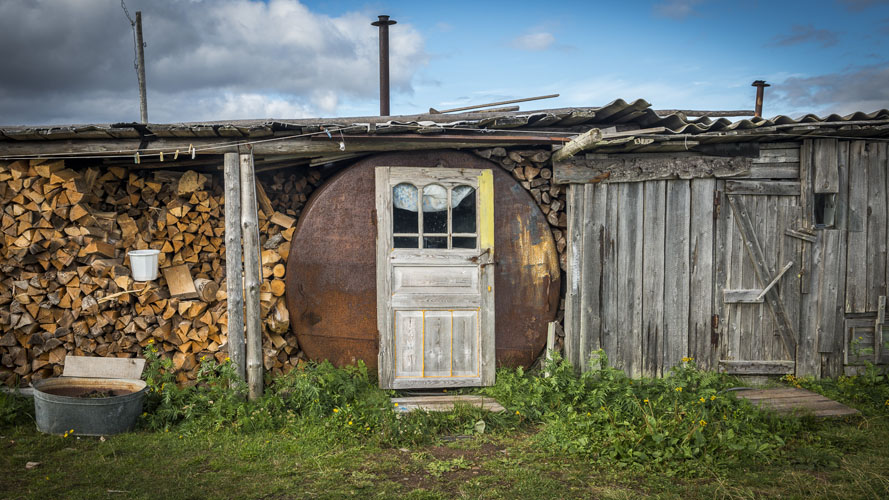
ONWARD TO THE KINGDOM OF THE BEARS AND WOLVES
The next day, we have the opportunity to stop and explore a small abandoned amethyst mine. It was an open pit mine. The Chinese have come to remove the solid steel machinery to recast it, the Russians not being champions of dismantling and recycling. It is not very difficult to find beautiful stones of amethyst and fluorite lying around. Everyone searches for the stones with their noses to the ground for about 30 minutes. Later, we stop at a chapel, where local fishermen gather to pray for miraculous catches.
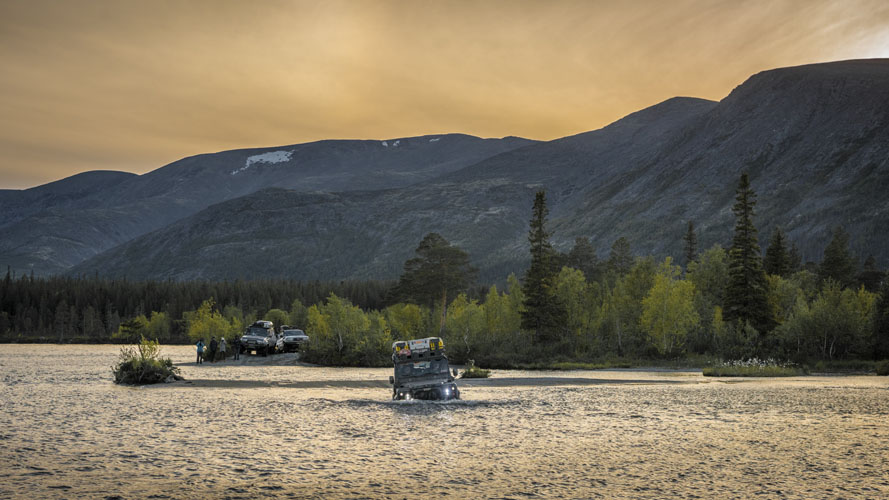
We then take advantage of the low tide and drive along the flat and accessible beaches which allows us to progress rapidly (a magical moment) . At the end of the day, as we exit a pine wood, we suddenly arrive at a mini arctic desert. Small sand dunes are revealed to our surprised eyes. What a contrast. It does not take very long before we are all enjoying some great sand driving . After playing like children , we set up the camp between the pine forest and the dunes. We don’t lack any firewood for the magnificent fire that keeps us warm after dark.
By now we have reached the easternmost point that a vehicle can reach on the Kola Peninsula. The eastern half of the peninsula remains an almost depopulated area accessible only by boat. ‘The kingdom of bears and wolves’.
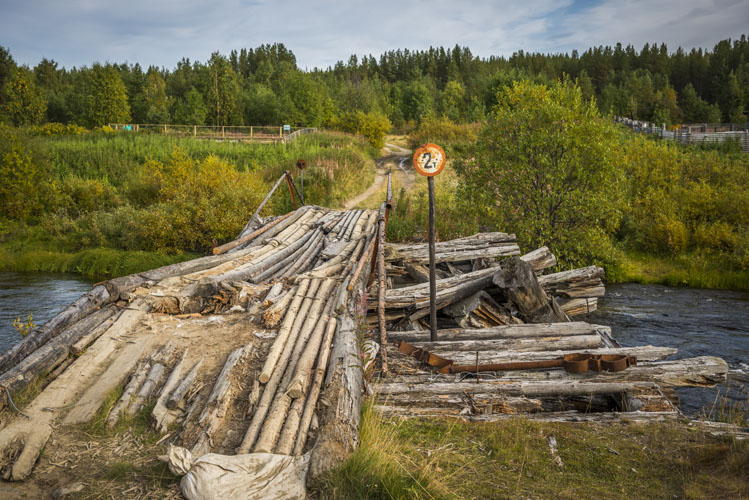
DEEP IN THE FOREST WHERE MAN HAS NO DOMAIN.
Following these ‘appetizers’ we now begin one of the more cautious portions on the journey. The plan is to climb from the White Sea to the central region of the peninsula, crossing the taiga through hills and lakes for about 250 km. Trails had been made in the time of the gulags by some unfortunate detainees … But since then, the vegetation has resumed its rights and taken over again, and the log bridges are only the shadow of their former selves . It is often wiser to skip them and ford the rivers instead. Nicolas convenes the group and consults with us. There is no question of embarking on this route without the total agreement of the group .This will be tough and mutual assistance will be necessary. In addition to being hampered by the vegetation, the track is extremely wet in places. There are many flooded areas. The June thawing totally transforms the northern soil into a quagmire. Some areas have been augmented with large logs positioned longitudinally to assist the passage of previous vehicles through this gloop. These turn out to be a trap, these “crocodiles”. They stand upright as soon as they are driven onto. These areas are taken very slowly and our winches are used frequently. At certain points,a pathfinder walks ahead of the vehicle, with a saw in his hand. The largest branches are spread or sliced. When a trunk 1m in diameter crosses the track, we break out the chainsaws.
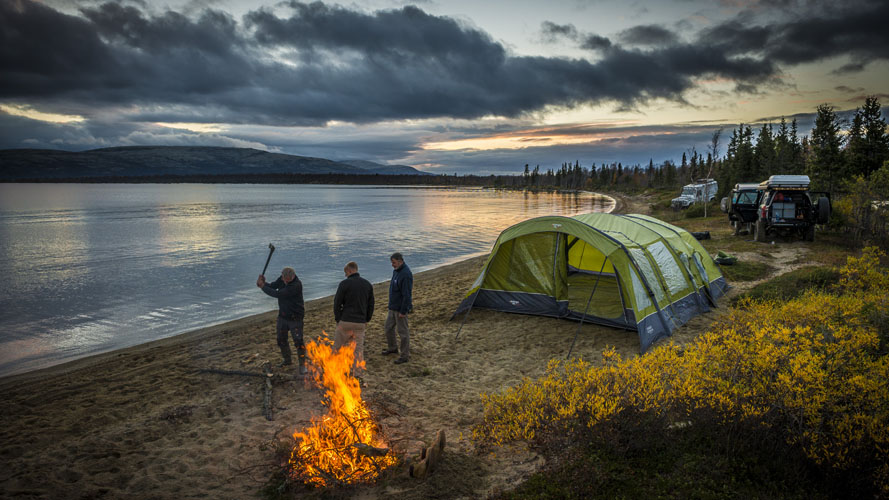
On the 2nd day, the hardest part of this section is over . We rejoin a marked trail from the north. This finally gives us an opportunity to better appreciate the sumptuous surroundings that we are passing through. The yellow-red fields compete with white lichens and other multi-colored mosses, while the myrtilliers dot the forest with bright red spots. This is truly an enchanted forest, where man no longer reigns, we observe many little fierce ptarmigans. On the ground, they still wear their summer plumage, but as soon as they take flight, we can see that the underside of their wings has already taken up its white winter livery.
This trail winds into the heart of the forest, when suddenly it leads to a long ribbon of flat asphalt 4 km by 40m wide. An old, abandoned military aviation runway. We take the opportunity to speed past 100km / h, which does great for morale.
We reach Kirovsk, a mining town at the foot of the Khibiny Mountains, where rooms await us in the best hotel in the region, usually enjoyed by oligarchs and politicians, (unless they are the same) … As an aside, the two main mines in the region are property of a certain Mr. Putin and another acolyte named Medvedev.
STRONG EMOTIONS, DANTESQUES AND SURREALISTS !!!
We leave well rested for the next, most technical part of this trip. The south-western crossing of the central mountains. These mountains are not high, only 1100m elevation. But the total absence of infrastructure makes them very difficult to access. To cross them is also to access the sacred lakes of the saamis (which are reputedly charged with supernatural power), real little jewels enshrined in the heart of the Mountains.
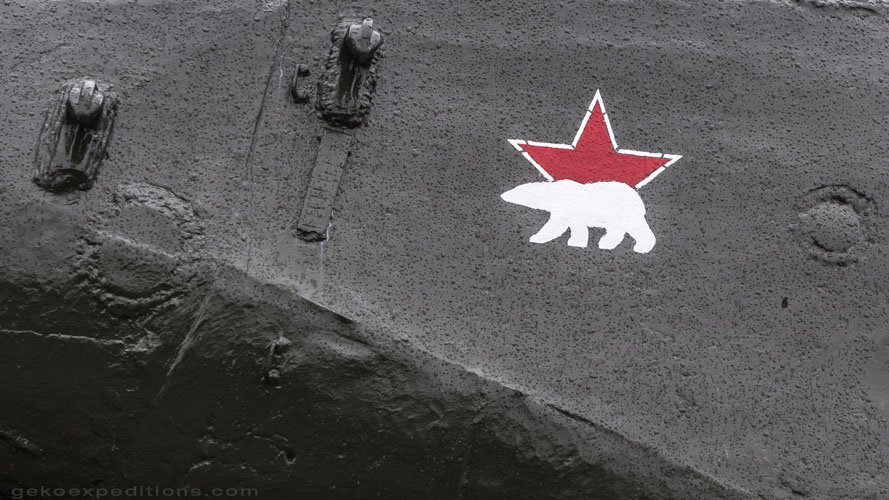
The first day is perfect. As we approach the first serious fords, we can see that the water level is rather low on this slope, a sign that it has not rained in recent days. Once the fords are checked out, some of the party let go and “clean the windscreen”. We camp at the edge of a majestic first lake. The contrast of the blue waters and the yellow-red forests is really striking. In 10 minutes we set up our large group shelter because the weather has become rainy and very cold.
If Nicholas was not here, and had not the former experience , nobody would believe that it was possible to pass this way in a vehicle. Overall, hardly a dozen 4x4s cross these mountains every year.
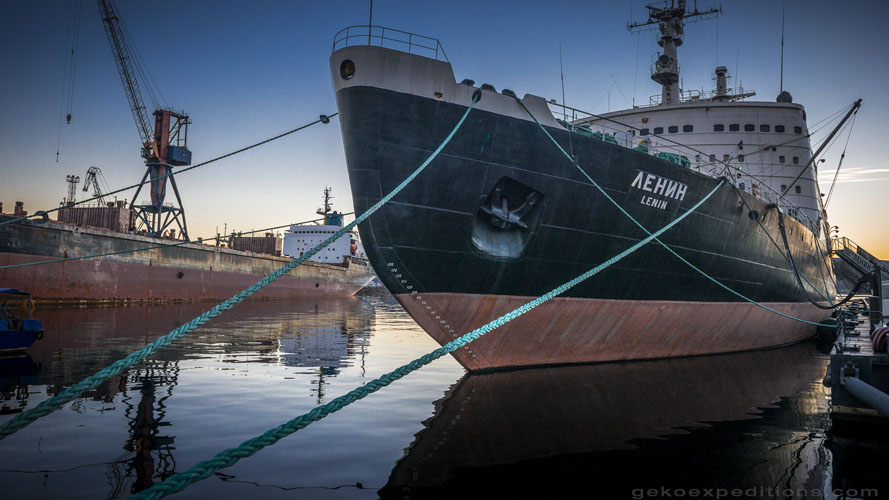
The climb is testing, we have to climb large blocks of rock wet with drizzle. The Hilux pickup is not at the party due to its low ground clearance. But thanks to excellent reading of the pitch,Patrick, the driver, steers with a masterful hand surprising everyone. However it is far from the experience of large stretches of sand in which he is accustomed to driving.
Occasionally The cloud veil cracks and the sun comes to revive the colors. Spectacular! Emotions are strong,we delight in the dantesque and surreal decor. We stop for lunch at a pass, enclosed by vertical rock walls of 450m. We feel like we have conquered Everest … and this is just the beginning.
Before descending, we must get through this mountain valley, which appears to have no visible track. However Nicolas confidently tells us “It is there” … Fortunately, it is him who leads the way, which reassures everyone. Next, we have to cross two mountain lakes. And the slopes around the lakes- are steep! Sometimes we scrape by with centimeters to spare.High on emotion. The downhill part involves partially driving in the bed of a river which at least offers a firm bottom.
HELL OF THE NORTH
The next day, we descend again and reach the edge of the trees. The terrain changes. And once again we enter a quagmire typical of these northern forests. Fortunately, the stones are never far away,which helps to avoid the vehicles sinking completely in the mud. But these stones also quickly become a source of trouble for the lowest vehicles. Scarcely visible in the mud, they surprise the drivers. The vehicles get stuck one after the other.Axles, leaves springs, lower control arms … Anything that is not 30cm above the ground is likely to hang on a rocky protrusion.
The Geko Patrol vehicle is equipped with BFGoodrich Mud 37-inch tires, and it becomes the true St. Bernard of the group. However it is the mutual assistance that prevails. A winch fails, then a 2nd. No matter, we are all aware that we are participating in a true and tough expedition, in a fabulous setting, which very few Westerners have had the chance to admire.
By dint of patience and effort, the reward finally arrives, a lake, unreal looking, bordered by a sandy beach. Some Magic at the end of the world … but it’s only the western shore. We still have to get around it to. Two more days driving will be necessary, between quagmires, spectacular altitude trails and beautiful lakeside. It is at this part of the trip that we cross the deepest fords. All the vehicles cross the fords without difficulty in up to 1m30 of water. The Patrol crosses first, with a 60m safety rope attached to the rear. The vehicles will be able to pass safely. Impressive for travelers accustomed to Africa …
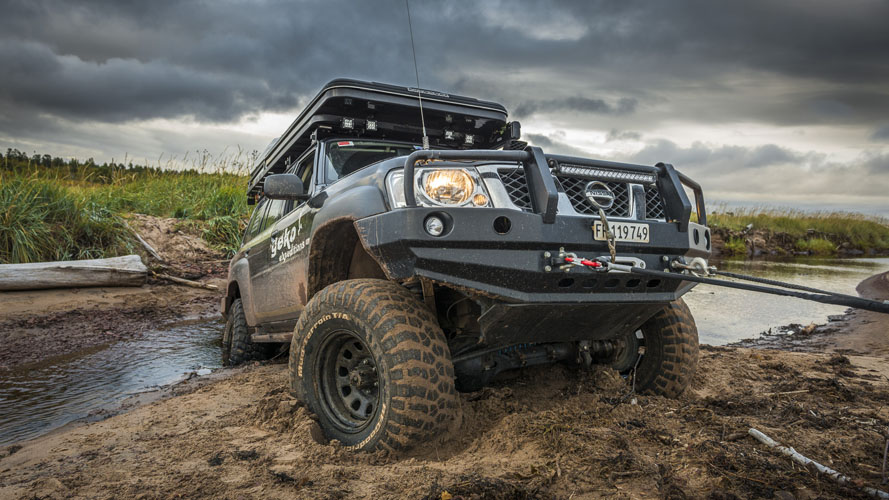
As we approach one of the last river crossings,a dilapidated bridge gives us a hard time. Our route is continually blocked by the mud (all vehicles without exception have gotten stuck). Then we finally reach the bank of this 80 m wide river with a low level of water … and also, you guessed it, round and slippery pebbles. Finally using a double winch everyone made it across. It took 5 hours to overcome this passage but thankfully in a good summer mood. Great blue sky, sun, 20 degrees, crazy colors and abundant water …
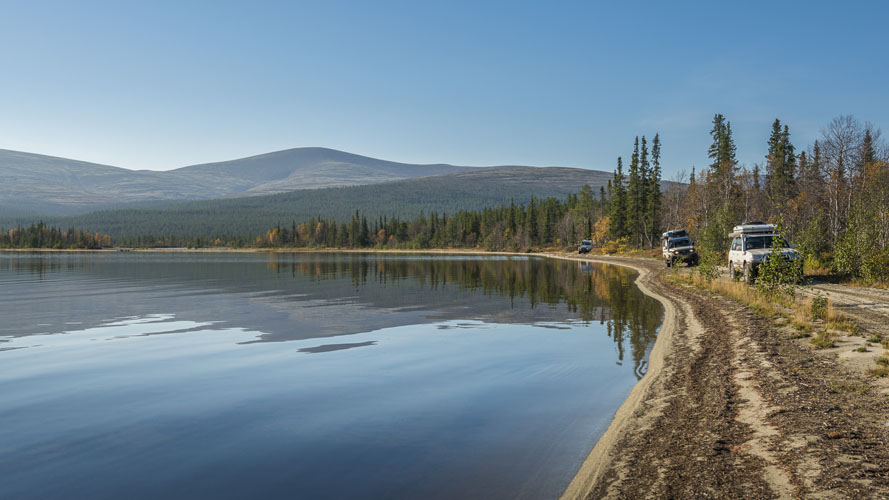
Tonight, we join civilization, and spend the night under a lavvu, or tepee of the nomadic breeders, with a roaring wood fire at its centre. A spectacular aurora borealis also dances in the sky rolling from one horizon to another, as if to salute our arrival on the sacred lands of saamis. Paul and Monica pass around a bottle of Rum that slipped through the customs net. A good evening.
THE SACRED MOUNTAINS
After passing through the mountains, Nicolas suggests that we climb to the top of the massive neighboring mountain. Now that we’re here, after all …
A good , old prospectors track leads us all the way there. We stop for a moment at the edge of a circus, which dominates the whole tundra running down to the Barents Sea. The weather is fine. The light that reigns here is simply unique. No need for filters on Photoshop or Instagram. Everything looks deep and “saturated”, mixing softness and strangeness. After all, don’t the saamis ascribe strange powers to these mountains? At the top, there is a succession of rocky high plateaus. The winds trace through this field of gigantic pebbles. After a short walk, we finally reach a cliff overlooking an inaccessible and totally preserved lake. We pose and admire the vista without a word.
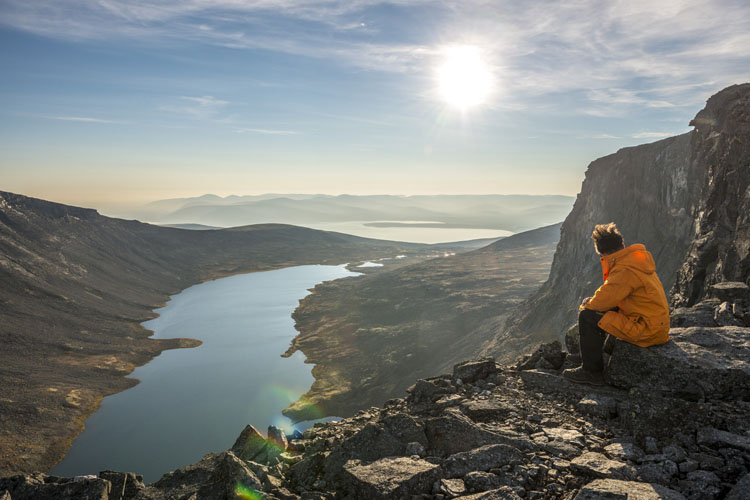
FEELING ASTONISHMENT, SADNESS AND RESPECT
The trail that leads back to the northeast of Murmansk is beautiful . About 200km from the capital of the north, we first encounter an old fishing village that has fallen into oblivion. Containing wrecks of rusty or rotten boats, dilapidated wooden barracks,and paths taken up by vegetation … A strange place, which yet is still inhabited. Our feelings oscillate between astonishment,sadness and respect. There is beauty in these vestiges of a flourishing past. And life always clings to these unlikely places. Gas deposits discovered offshore nearby could change the deal soon.
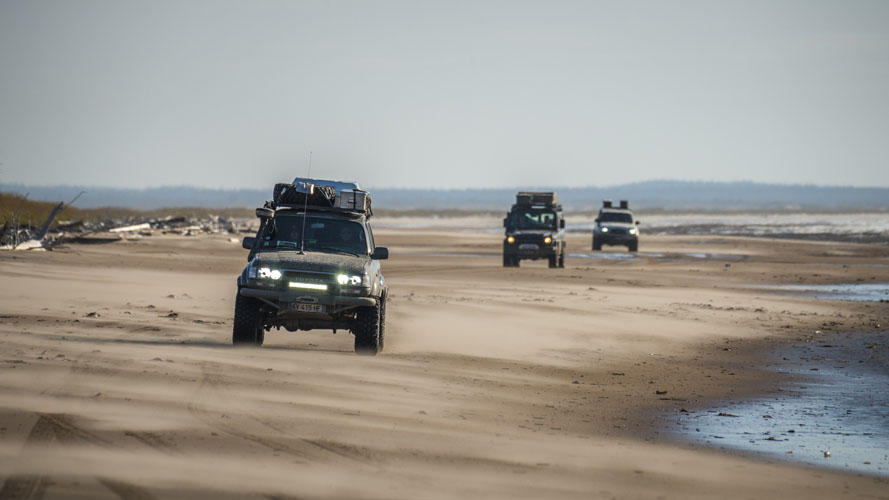
We continue across lost tracks to the Sea. Sidereal beauty. Always the pebbles, but declined in number this time. However now we see giant pebbles, up to 2 meters in diameter, polished, pearly and round or oval. A giant pebble beach, the beach of an Arctic Jurassic Park. Some of these rocks are more than 15 meters inshore high on the beach, making it easy to imagine the violence of the elements where the sea manages to propel these giant rocks up the beach. We feel small, very small at the end of the World.
Murmansk does not match its sordid and industrial reputation,instead we discover a modern and pleasant city. A detour through the café of the railway station, a remnant of the old Soviet canteens, reminds us where we are. We visit the first Russian nuclear icebreaker, the Lenin and discover a whole section of Russian polar exploration. Very Exciting.
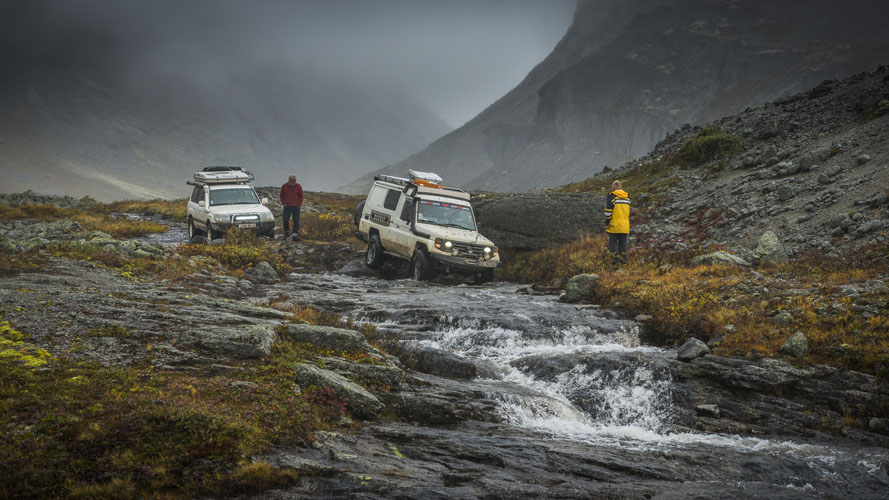
After a well deserved rest, we set off from Murmansk to leave Russia by the north-western route to Norway. It is now mid-September, and there is an explosion of color everywhere. Our exit from Russia via the Norwegian port of Kirkenes seems a bit like the end of a hectic journey, even though we are not yet back home.
We are all conscious of having lived and experienced an extraordinary and truly privileged expedition. Through shared adversity and pulling together as a team to help get the party through , strong bonds were established between the participants. On the organizational side, both the administrative preparation and the guidance and supervision of Geko Expeditions were of a very high standard, an imperative requirement for the success of such an adventure. Congratulations and thanks to Nicolas, Olivier and Gerard.
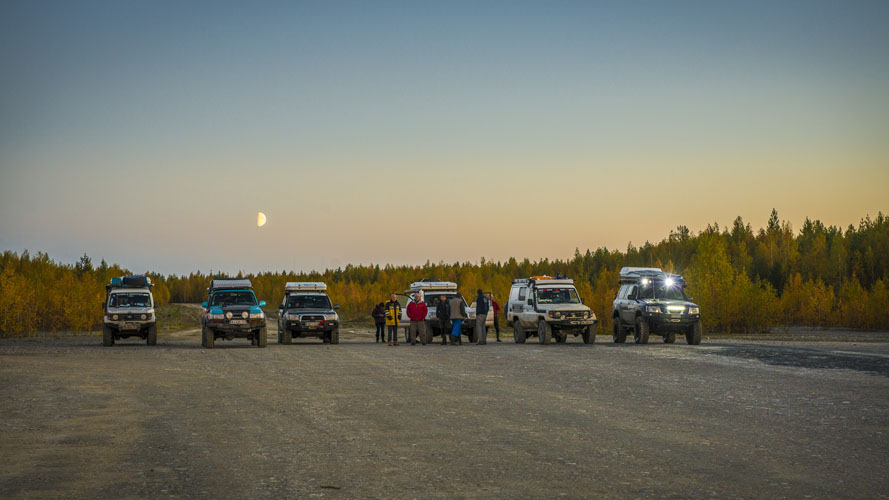
Now that we have tasted it, we have a strong desire to return to Russia.
Russia – Objective Murmansk 4WD Touring in the Russian Kola Peninsula 

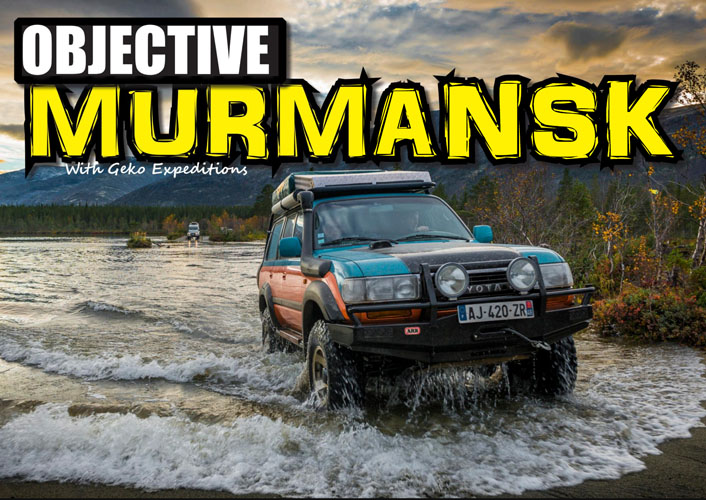
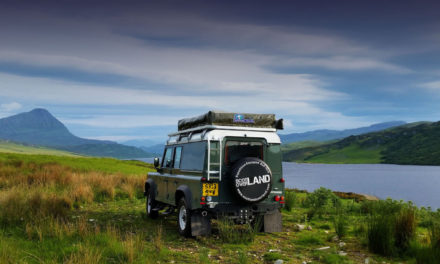
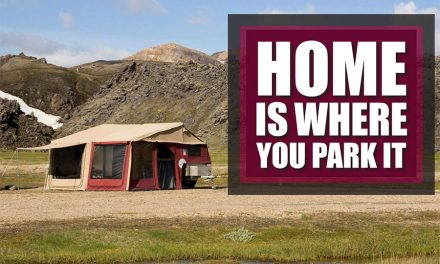
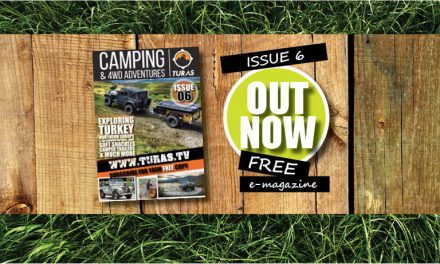
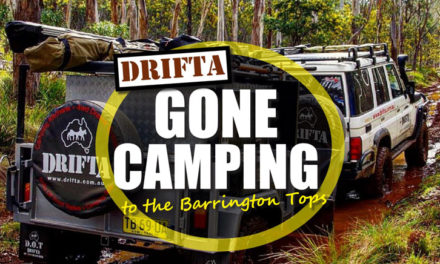
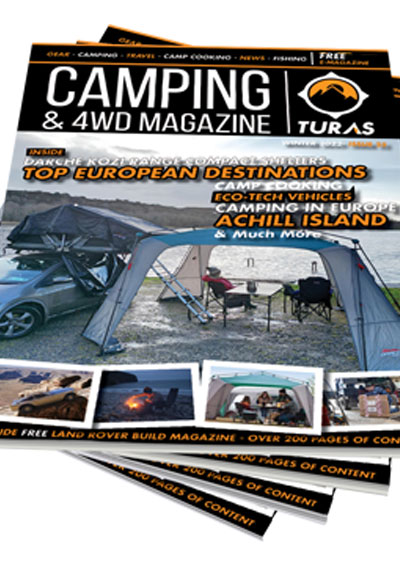

wow amazing trip. I would love to see a map of the path you took